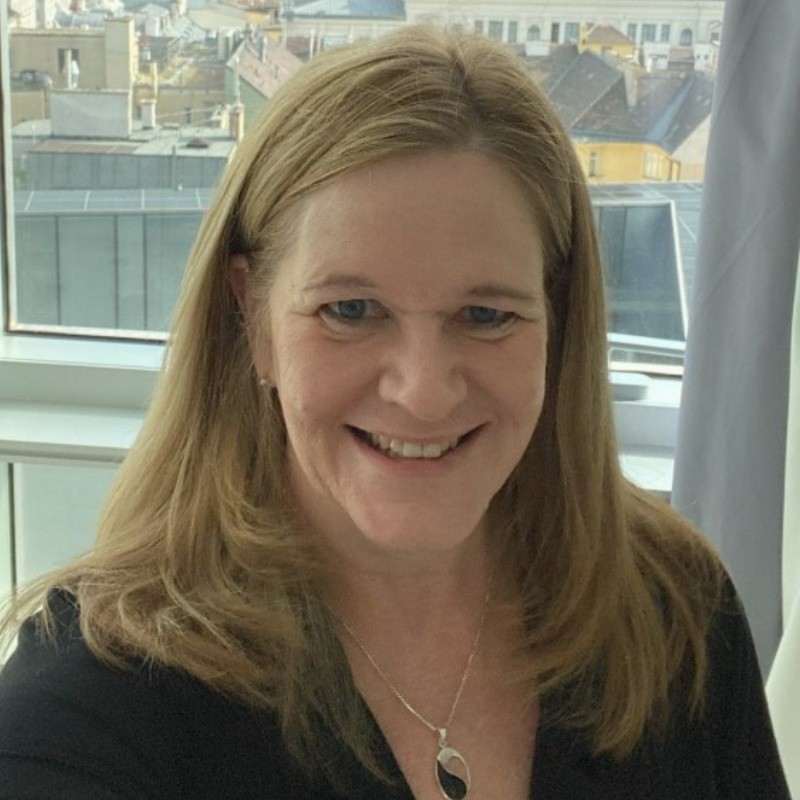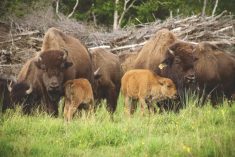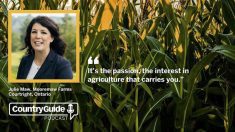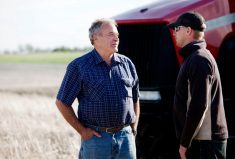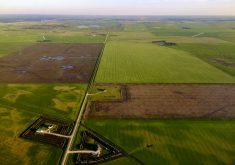Jeff Barlow’s 4,200-acre farm is near the town of Binbrook, about 30 km south of Hamilton, Ontario. “Technically, within the city limits,” he says. Barlow and his father grow soybeans, corn and soft red winter wheat with help from employees, Jeff’s three teenage sons, and support from Jeff’s wife, Dianne, who works off the farm as an elementary school principal.
There are benefits to living next door to Canada’s largest urban area. Dianne grew up in Toronto. Barlow went to McMaster university in nearby Hamilton, then worked in an office in downtown Toronto before he came back to the farm. Now, they take advantage of living so close to the city. They love having access to great shopping, restaurants and plays, and, living so close to a major city, Barlow often picks up takeout from one of several nearby restaurants. And he never drives more than 20 minutes for parts.
But living so close to a growing urban area also brings challenges that Barlow’s ancestors probably didn’t anticipate when they set up their homestead in the area in 1843. The local price of farmland is linked to demand for commercial and residential development — not to the price of wheat. “If you’re not in the greenbelt,” Barlow says, “there’s a high potential for land to be commercially developed.”
Read Also

The big squeeze: How to be fair to siblings during farm succession
Managing sibling business relationships on family farms.
Barlow has seen nearby 100-acre parcels of farmland destined for development sell for anywhere from $40 to $80 million. The price of this land, he says, is “inflated with potential.” Land that’s less likely to be developed trades at what Barlow thinks of as “a more realistic range.” FCC’s “farmland values calculator,” shows cultivated farmland around Hamilton selling for an average price of $22,977 per acre in the last year. (For comparison, FCC shows the average price of land in this author’s area of southeast Saskatchewan at $1,920 per acre. The Ontario price is almost 12 times higher.)
Barlow can grow higher-value crops than farmers in other parts of Canada, but generally, his cost structures are similar to other grain and oilseed farmers. High land prices in his immediate area, though, are a limitation on buying more farmland.
Managing 43 landlords
Compared to the purchase price, farmland rental costs in the area are low — approximately one per cent of the value of the land, Barlow estimates. For the owners, land in the area is more of an investment than a desire to farm. “To get the money out, you have to sell it,” Barlow says.
- READ MORE: Share of rented land increasing
But available farmland in his immediate area, which Barlow sees as a roughly 10-mile radius around his farm headquarters, has been divided into relatively small parcels of land. To put together enough small parcels of land to build an economically viable farm, Barlow currently rents land from 43 unique landlords.

Since he’s started farming, local land ownership has changed dramatically. In past decades, a lot of nearby farmland was owned by prominent local farmers. When they retired, they kept the land in the family, whether they farmed it themselves or not. In those days, most of Barlow’s landlords were retired farmers themselves, and understood farming.
But over time, the demographics of Hamilton area landowners have changed. Now, Barlow says, “The majority of my landlords don’t understand farming at all.” Barlow’s current landlords are a diverse mix of long-term owners, investors and new immigrants from countries around the globe. “They come from all different cultures,” Barlow says.
Most of these newer owners bought farmland as an investment, with an eye on future development — not because they’re planning to grow corn themselves. Some of them aren’t very interested in agriculture, or even what’s growing on their land. “There’s a couple of them that haven’t seen their own field in 15 years.”
Because most of his landlords don’t know much about farming, Barlow makes time to visit with all of them annually to let them know what’s happening on their land and to keep the lines of communication open. Every December, Barlow and his father deliver Christmas gift baskets to all the landlords that live close by. “It takes about a week,” Barlow says.
Each Christmas stop is a different experience. When they stop in to see the Eastern European immigrant landlords, he says, “you need to share a drink with them.” An Italian landlord often sends the Barlows home with a bottle of wine. The Barlows never leave their long-time Filipino landlord’s house without some kind of gift. “They like to give you something,” he says. Almost all the landlords invite Barlow in to talk, if not about the crops, then about their other interests. (One landlord likes dirt biking.) A couple of his older landlords are just happy to have a nice visit, and especially enjoy talking about their grandchildren. “If they offer you tea, you say, ‘Yeah, I’d love one,’” Barlow says.
The thought of managing relationships with 43 different landlords seems overwhelming. But as Barlow points out, “You’re just hearing about them now, thinking about all of them at once.” For him, the number and variety of landlords has grown gradually over time and is just one more part of his business. He’s known most of them for years and is genuinely interested in stopping by to see them. For the few landlords that live too far away for a Christmas visit, Barlow mails a handwritten letter along with his annual rent cheque.
Agronomy on rented land
Occasionally, landlords sell their land or find new renters. With 43 landlords, Barlow expects his land base to change regularly. “Probably every year, at least one field changes hands,” he says. Barlow continuously scouts for new rental opportunities that would match his existing land base. “I try to always gain one whenever I lose one.”
Because it’s unlikely he’ll be able to significantly increase his owned land base in this location, Barlow does his best to increase his profits on the land he has. He keeps an eye on technological developments but aims his efforts at incremental improvements. “Once you’ve been farming for a while,” he says, “there aren’t a lot of options to make big, dramatic changes. You’ve got good equipment, and you know what varieties you can plant,” he says. “You don’t just go and buy a different sprayer and somehow double your yield.”
Barlow identifies profitable changes through regular on-farm trials and field experiments, most of which are designed with a consultant. “He’s really big into trying to get us to try different things,” Barlow says. Not that Barlow needs convincing. He has an interest in new technology and is eager to try new things. Barlow’s consultant also uses soil tests and weather information to develop SWAT maps for each of their fields, so Barlow can apply fertilizer and seed at variable rates. “We look at the potential of each piece of land,” he says.
Having access to up-to-the-minute data makes these experiments more valuable. Barlow uses the JD Operations Centre system to gather and store this information. His newer machinery came equipped with this system and he’s retrofitted older equipment to make it work across the farm. “It keeps track of everything,” he says. That includes input costs, and sales revenues, “down to the per field cost of production per acre.”
On land he owns, Barlow invests in tile drainage. The investment pays off, but it’s not economically feasible on rented land, so before he signs new rental contracts, Barlow uses drones to take aerial pictures of the land to investigate potential draining problems and areas where he might have trouble accessing fields.
Managing inputs on a constantly changing land base can be complicated. Barlow uses a four-year rotation on his own land, and also on rented land he expects to be farming for the medium-term. “I can kind of treat it like a normal farm.” But when he’s been given notice that a particular piece of rented land will likely be sold in the near future, “there could be some really short-term outlooks,” he says. This doesn’t happen often, but when it does, Barlow manages short-term fields on a year-to-year basis, making production decisions based on what will grow the best crop in the current year.
Building up the land base
While Barlow has recently purchased some farmland, he expects it to continue to get more difficult to buy nearby farmland at an affordable price. “There are probably a lot of us waiting for opportunities to buy. That opportunity may not arise,” he says.
One tactic Barlow has used is to buy farmland that already has a house on it. After subdividing the land around the house and selling a small piece as an acreage, Barlow can farm the remaining land and leave a new acreage owner happy not to have any immediate neighbours. “It’s a really long process and it’s very expensive,” he says, “but you could have a $600- or $700,000 house sitting there.”
In the long run, Barlow expects his rental situation to become more difficult. Some land is likely to shift out of agriculture altogether. And there may be fewer farmland owners. “It will probably be consolidated to a small number of pretty aggressive investment-type people.” A few families in the area have already made big investments in farmland. “They won’t farm themselves,” he says. “They’ll rent it out.” Barlow expects some of these large-scale landlords to find preferred renters, or to choose to deal with just one renter instead of several different farmers.
Barlow acknowledges that living next to the city has brought some restrictions to his farm business. “I think it would’ve been easier to become a very successful well-off farmer in Saskatchewan than it was in Ontario,” he says. But he is optimistic about the future and doesn’t believe city growth will stop him from farming. “In my lifetime, certainly not,” he says.
It’s true that if Hamilton continues expanding, it could force some changes, but Barlow says he won’t move far. He’s rooted in the area and he loves it. He also serves as a director for Grain Farmers of Ontario and is enthusiastic about the future of agriculture and his own family’s future opportunities. “Maybe it would bump us out of our northern-most farms,” he says. “But that doesn’t mean we can’t go south.”
– This article was originally published in the February 27, 2024 issue of Country Guide.

